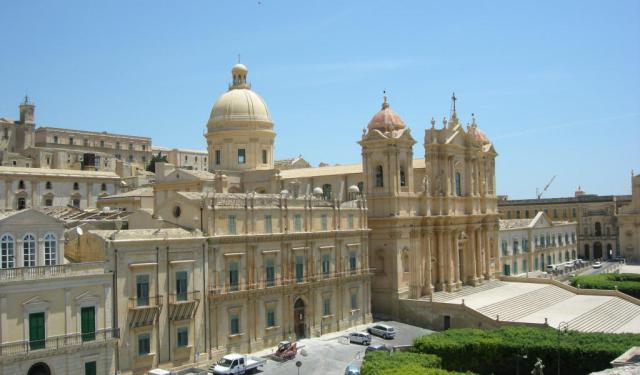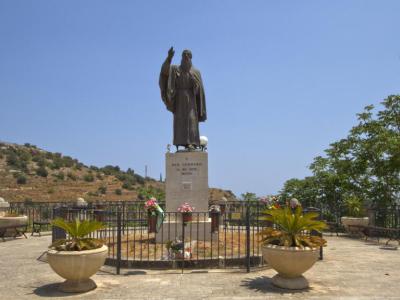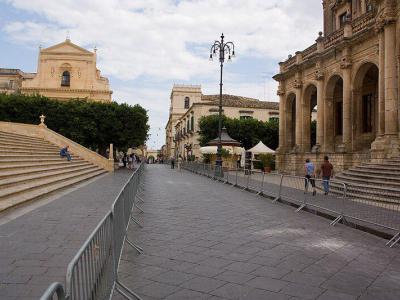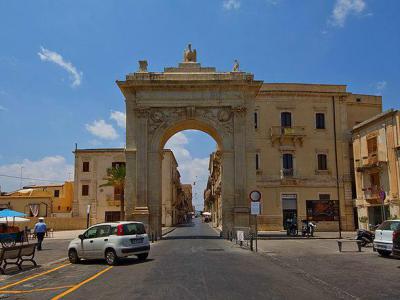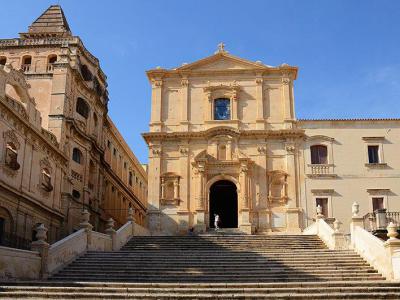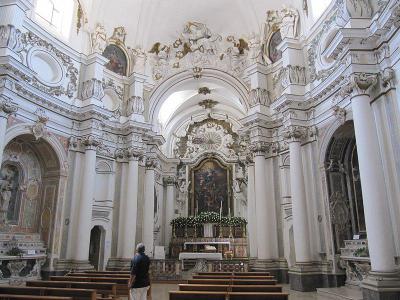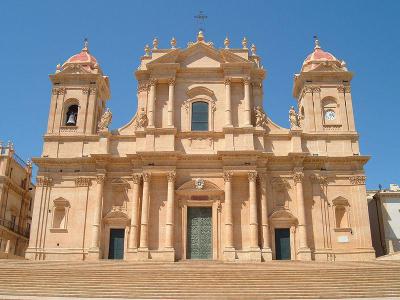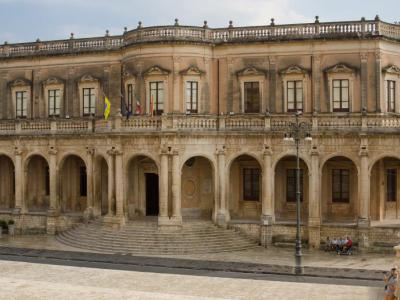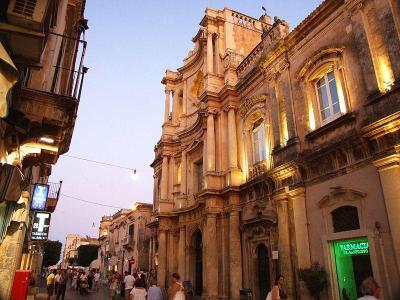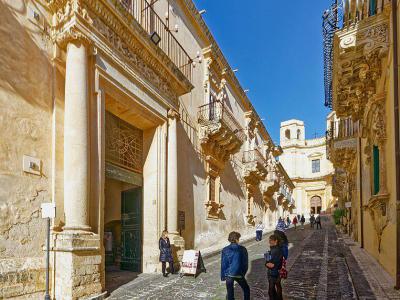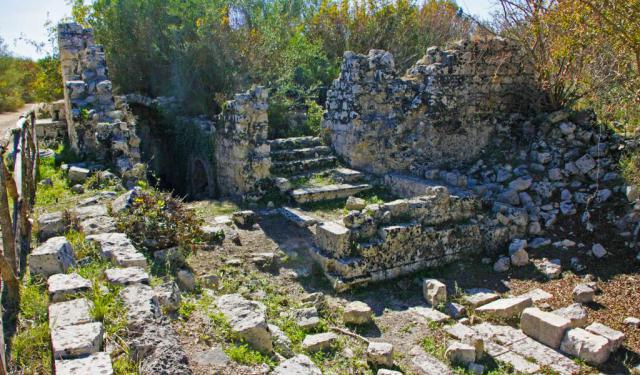Noto Introduction Walking Tour (Self Guided), Noto
Perched high on a plateau with a panoramic view of the Asinaro Valley, in the shadow of Mount Alveria, the city of Noto is renowned as the Baroque capital of Sicily.
The name "Noto" finds its roots in the ancient Greek word "Neaton," which is likely translated to "south". Later, it was Romanized as "Netum." The Romans granted this territory to Hiero II in 263 BCE. Legend has it that both Daedalus, the father of Icarus, and Hercules found respite in this land during their journeys.
Noto fell under Muslim rule in 866 and later was the last Islamic stronghold in Sicily reclaimed by the Christians, in 1091. During the Norman era, the city thrived and became quite prosperous.
In the 16th and 17th centuries, Noto was a hub of intellectual activity. King Ferdinand III even granted it the "Ingenious City" title in 1503. Tragically, the medieval town was razed by the 1693 Sicilian earthquake, resulting in significant loss of life. Noto was then meticulously rebuilt in its present location, just 8 kilometers north of its ancient counterpart, Noto Antica, displaying a remarkable architectural homogeneity and becoming a UNESCO World Heritage Site.
The city's rebellion against the House of Bourbon in 1860 and subsequent annexation to Piedmont marked a significant chapter in Noto's history. The city emerged from the shadow of fascism in July 1943, and in the 1946 referendum, its residents voted in favor of the monarchy.
One of the first sites to explore in Noto is the Statue of San Corrado, a beloved local saint. You can stroll along the elegant Corso Vittorio Emanuele III, a historic street lined with magnificent buildings and quaint cafes.
Passing through the majestic Royal Gate (Porta Reale) you'll eventually discover the splendid Church of Santa Chiara, a fine example of Sicilian Baroque. As you continue your journey, don't miss the Noto Cathedral, an iconic landmark showcasing the town's religious heritage.
Venturing towards the end of Via Corrado Nicolaci, the street named after the town's famous son, Corrado Nicolaci, make sure to visit Palazzo Nicolaci, a breathtaking palace adorned with ornate balconies and sculptures.
A testament to resilience and reinvention, Noto has witnessed the rise and fall of various cultures, all leaving their mark on its identity. As each day draws to a close, the limestone buildings in Noto bask in the sun's golden embrace, casting a rich, honeyed hue over the city. So, come and explore the secrets of this enchanting town, where history and art merge to create a delightful experience.
The name "Noto" finds its roots in the ancient Greek word "Neaton," which is likely translated to "south". Later, it was Romanized as "Netum." The Romans granted this territory to Hiero II in 263 BCE. Legend has it that both Daedalus, the father of Icarus, and Hercules found respite in this land during their journeys.
Noto fell under Muslim rule in 866 and later was the last Islamic stronghold in Sicily reclaimed by the Christians, in 1091. During the Norman era, the city thrived and became quite prosperous.
In the 16th and 17th centuries, Noto was a hub of intellectual activity. King Ferdinand III even granted it the "Ingenious City" title in 1503. Tragically, the medieval town was razed by the 1693 Sicilian earthquake, resulting in significant loss of life. Noto was then meticulously rebuilt in its present location, just 8 kilometers north of its ancient counterpart, Noto Antica, displaying a remarkable architectural homogeneity and becoming a UNESCO World Heritage Site.
The city's rebellion against the House of Bourbon in 1860 and subsequent annexation to Piedmont marked a significant chapter in Noto's history. The city emerged from the shadow of fascism in July 1943, and in the 1946 referendum, its residents voted in favor of the monarchy.
One of the first sites to explore in Noto is the Statue of San Corrado, a beloved local saint. You can stroll along the elegant Corso Vittorio Emanuele III, a historic street lined with magnificent buildings and quaint cafes.
Passing through the majestic Royal Gate (Porta Reale) you'll eventually discover the splendid Church of Santa Chiara, a fine example of Sicilian Baroque. As you continue your journey, don't miss the Noto Cathedral, an iconic landmark showcasing the town's religious heritage.
Venturing towards the end of Via Corrado Nicolaci, the street named after the town's famous son, Corrado Nicolaci, make sure to visit Palazzo Nicolaci, a breathtaking palace adorned with ornate balconies and sculptures.
A testament to resilience and reinvention, Noto has witnessed the rise and fall of various cultures, all leaving their mark on its identity. As each day draws to a close, the limestone buildings in Noto bask in the sun's golden embrace, casting a rich, honeyed hue over the city. So, come and explore the secrets of this enchanting town, where history and art merge to create a delightful experience.
How it works: Download the app "GPSmyCity: Walks in 1K+ Cities" from Apple App Store or Google Play Store to your mobile phone or tablet. The app turns your mobile device into a personal tour guide and its built-in GPS navigation functions guide you from one tour stop to next. The app works offline, so no data plan is needed when traveling abroad.
Noto Introduction Walking Tour Map
Guide Name: Noto Introduction Walking Tour
Guide Location: Italy » Noto (See other walking tours in Noto)
Guide Type: Self-guided Walking Tour (Sightseeing)
# of Attractions: 11
Tour Duration: 1 Hour(s)
Travel Distance: 0.9 Km or 0.6 Miles
Author: DanaOffice
Sight(s) Featured in This Guide:
Guide Location: Italy » Noto (See other walking tours in Noto)
Guide Type: Self-guided Walking Tour (Sightseeing)
# of Attractions: 11
Tour Duration: 1 Hour(s)
Travel Distance: 0.9 Km or 0.6 Miles
Author: DanaOffice
Sight(s) Featured in This Guide:
- Statue of San Corrado
- Corso Vittorio Emanuele III (Vittorio Emanuele III Street)
- Porta Reale (Royal Gate)
- Chiesa di San Francesco d'Assisi all'Immacolata (Church of Saint Francis of Assisi to the Immaculate)
- Chiesa di Santa Chiara (Church of Santa Chiara)
- Basilica Santissimo Salvatore
- Noto Cathedral
- Ducezio Palace
- Church of San Carlo al Corso
- Via Corrado Nicolaci (Corrado Nicolaci Street)
- Palazzo Nicolaci (Nicolaci Palace)
1) Statue of San Corrado
The Statue of San Corrado is a remarkable bronze sculpture portraying Saint Conrad of Piacenza, the revered patron saint of Noto. Saint Conrad, also known as Corrado Confalonieri, was born in the year 1290. He passed away while deep in prayer, kneeling before a crucifix, on February 19, 1351, in Netum, which is present-day Noto Antica.
In a significant event that took place on June 2, 1625, Saint Conrad was canonized by Cardinal Odoardo Farnese in a solemn ceremony. To honor this beloved patron saint, a bronze statue was erected in his likeness in 1955. The statue portrays Saint Conrad of Piacenza blessing the faithful and stands approximately 2 meters tall. It is mounted on a sturdy marble base. The artist behind this magnificent sculpture is Mario Ferretti, a Tuscan sculptor.
The terrace where the statue stands overlooks the Cozzo Marotta Hill and offers a captivating panoramic view. Atop the hill's ridge, you can also observe visible rock tombs and the remnants of the ancient Necropolis of Ancient Noto.
In a significant event that took place on June 2, 1625, Saint Conrad was canonized by Cardinal Odoardo Farnese in a solemn ceremony. To honor this beloved patron saint, a bronze statue was erected in his likeness in 1955. The statue portrays Saint Conrad of Piacenza blessing the faithful and stands approximately 2 meters tall. It is mounted on a sturdy marble base. The artist behind this magnificent sculpture is Mario Ferretti, a Tuscan sculptor.
The terrace where the statue stands overlooks the Cozzo Marotta Hill and offers a captivating panoramic view. Atop the hill's ridge, you can also observe visible rock tombs and the remnants of the ancient Necropolis of Ancient Noto.
2) Corso Vittorio Emanuele III (Vittorio Emanuele III Street) (must see)
Vittorio Emanuele III Street is one of the main thoroughfares in Noto. This picturesque street is renowned for its stunning Baroque architecture and is considered one of the most beautiful streets in Sicily. Vittorio Emanuele III street runs through the heart of Noto, connecting several prominent landmarks and serving as a focal point for both locals and visitors.
Lined with elegant palaces, churches, and historic buildings, Vittorio Emanuele III street showcases the town's architectural splendor. Many of these structures were meticulously rebuilt in the Baroque style following the devastating earthquake of 1693 that destroyed much of the original town. Some notable landmarks along the way include the stunning Noto Cathedral, the Church of San Domenico, and the Palazzo Ducezio, which houses the town hall and a museum.
In addition to its architectural treasures, Vittorio Emanuele III street is a lively and vibrant street, often bustling with locals and tourists alike. Cafés, restaurants, shops, and boutiques line the street, offering opportunities to savor traditional Sicilian cuisine and shop for local products and souvenirs.
Lined with elegant palaces, churches, and historic buildings, Vittorio Emanuele III street showcases the town's architectural splendor. Many of these structures were meticulously rebuilt in the Baroque style following the devastating earthquake of 1693 that destroyed much of the original town. Some notable landmarks along the way include the stunning Noto Cathedral, the Church of San Domenico, and the Palazzo Ducezio, which houses the town hall and a museum.
In addition to its architectural treasures, Vittorio Emanuele III street is a lively and vibrant street, often bustling with locals and tourists alike. Cafés, restaurants, shops, and boutiques line the street, offering opportunities to savor traditional Sicilian cuisine and shop for local products and souvenirs.
3) Porta Reale (Royal Gate)
The Royal Gate is one of the main entry points to the town. Located at the eastern end of Corso Vittorio Emanuele III, one of Noto's main streets, Royal Gate is a stunning example of Baroque architecture and is an integral part of the town's identity.
Built in the 18th century during the reconstruction of Noto following the devastating earthquake of 1693, its design embodies the elegance and opulence of the Sicilian Baroque style, characterized by intricate decorations, sculpted details, and a sense of grandeur.
The gate's façade features ornate Baroque motifs, including floral decorations, sculpted cherubs, and the royal coat of arms of the Kingdom of Sicily, from which it derives its name. Above the gate, a Latin inscription commemorates King Ferdinand IV of Bourbon, who played a significant role in the town's reconstruction.
Porta Reale is not only an architectural marvel but also serves as a symbolic entryway into Noto's historic center, which is a UNESCO World Heritage Site. As you pass through the gate, you'll find yourself immersed in the charming streets and squares of Noto, with its splendid Baroque buildings, churches, and palaces.
Built in the 18th century during the reconstruction of Noto following the devastating earthquake of 1693, its design embodies the elegance and opulence of the Sicilian Baroque style, characterized by intricate decorations, sculpted details, and a sense of grandeur.
The gate's façade features ornate Baroque motifs, including floral decorations, sculpted cherubs, and the royal coat of arms of the Kingdom of Sicily, from which it derives its name. Above the gate, a Latin inscription commemorates King Ferdinand IV of Bourbon, who played a significant role in the town's reconstruction.
Porta Reale is not only an architectural marvel but also serves as a symbolic entryway into Noto's historic center, which is a UNESCO World Heritage Site. As you pass through the gate, you'll find yourself immersed in the charming streets and squares of Noto, with its splendid Baroque buildings, churches, and palaces.
4) Chiesa di San Francesco d'Assisi all'Immacolata (Church of Saint Francis of Assisi to the Immaculate)
The Church of Saint Francis of Assisi to the Immaculate is located at the pinnacle of a picturesque three-flight staircase. This church, renowned for its architectural splendor, was crafted between 1704 and 1750 under the architectural guidance of Rosario Gagliardi and Vincenzo Sinatra.
The façade of the church is a masterpiece of Baroque design. It is structured into two orders of pilasters adorned with Corinthian capitals and is elegantly crowned by a tympanum. At the center of this imposing façade, an exquisite portal adorned with baroque columns, intricately sculpted with foliate motifs, takes center stage.
Inside the church, which features a single nave and a Latin cross layout, visitors can admire a wealth of eighteenth-century paintings and funerary monuments. The apse houses a gilded wooden statue of the Immaculate Virgin dating back to 1504, attributed to the skilled hand of Antonio Monachello.
Two side chapels within the church, devoted to Saint Francis of Assisi and Saint Anthony of Padua, are masterpieces crafted by the plasterer Giuseppe Gianforma, a contemporary of Serpotta.
The façade of the church is a masterpiece of Baroque design. It is structured into two orders of pilasters adorned with Corinthian capitals and is elegantly crowned by a tympanum. At the center of this imposing façade, an exquisite portal adorned with baroque columns, intricately sculpted with foliate motifs, takes center stage.
Inside the church, which features a single nave and a Latin cross layout, visitors can admire a wealth of eighteenth-century paintings and funerary monuments. The apse houses a gilded wooden statue of the Immaculate Virgin dating back to 1504, attributed to the skilled hand of Antonio Monachello.
Two side chapels within the church, devoted to Saint Francis of Assisi and Saint Anthony of Padua, are masterpieces crafted by the plasterer Giuseppe Gianforma, a contemporary of Serpotta.
5) Chiesa di Santa Chiara (Church of Santa Chiara) (must see)
The Church of Santa Chiara, officially known as the Church of Santa Maria Assunta, was designed by the esteemed architect Rosario Gagliardi in the year 1730. This architectural gem was completed in 1758 and is intricately linked to the former convent of the Benedictine nuns, now transformed into the civic museum of Noto.
Originally, the façade of the Church of Santa Chiara graced Corso Vittorio Emanuele. This façade featured a striking portal embellished with a broken arch, with a central window sporting a sizable circular tympanum adorned with battlements. However, due to excavation efforts in the 19th century, this entrance was elevated above street level, rendering it impassable.
The present rectangular façade, now accessible via a small staircase on Via Capponi, showcases an entrance portal framed by two imposing Tuscan-style columns, each crowned with a distinctive Iblean stone cup. Ascending higher, you'll encounter the bell tower, accentuated by two capitals at its corners.
Upon stepping inside the church, visitors are enveloped by a profusion of decorations, cherubs, and stuccos, making it one of Sicily's most significant examples of Baroque architectural style. The interior boasts a single ovoid-shaped nave encircled by twelve sturdy stone columns. Each of these columns is graced by statues of the Apostles, masterfully created by the decorator and plasterer Basile.
Originally, the façade of the Church of Santa Chiara graced Corso Vittorio Emanuele. This façade featured a striking portal embellished with a broken arch, with a central window sporting a sizable circular tympanum adorned with battlements. However, due to excavation efforts in the 19th century, this entrance was elevated above street level, rendering it impassable.
The present rectangular façade, now accessible via a small staircase on Via Capponi, showcases an entrance portal framed by two imposing Tuscan-style columns, each crowned with a distinctive Iblean stone cup. Ascending higher, you'll encounter the bell tower, accentuated by two capitals at its corners.
Upon stepping inside the church, visitors are enveloped by a profusion of decorations, cherubs, and stuccos, making it one of Sicily's most significant examples of Baroque architectural style. The interior boasts a single ovoid-shaped nave encircled by twelve sturdy stone columns. Each of these columns is graced by statues of the Apostles, masterfully created by the decorator and plasterer Basile.
6) Basilica Santissimo Salvatore
The Basilica Santissimo Salvatore is a remarkable example of Baroque architecture and a Roman Catholic church. This sacred edifice is accompanied by an adjacent Benedictine monastery that has undergone a significant transformation over time. While the church remains consecrated and serves its religious purpose, the adjoining convent no longer houses cloistered nuns but is instead inhabited by seminarians.
Historically, the present church and monastery, originally dedicated to the Holy Saviour, replaced an earlier complex. The previous convent was renowned for housing the relics of San Destituto. Today, the buildings adjacent to the Basilica Santissimo Salvatore serve as the seminary of the Diocese of Noto. Part of the seminary had to be reconstructed in 1932 following a fire. Known as the Seminario Nuovo, it was formerly located adjacent to the Cathedral of Noto.
One of the most striking features of the Basilica Santissimo Salvatore is its recently restored interior, which is considered the most impressive in Noto. The interior is adorned with a magnificent vault fresco painted by Antonio Mazza, depicting the descent of the Holy Spirit. This breathtaking artwork adds to the spiritual ambiance of the church.
The exterior of the church, notably its façade, was also crafted by Antonio Mazza and completed in 1791. It reflects influences of a more restrained neoclassical style, showcasing a harmonious blend of architectural elements. The church's façade and counterfacade stand out for their second-story balconies adorned with intricate iron grillwork. These balconies were designed to allow cloistered nuns to attend Mass separately from the lay public while also providing them with a view of the bustling piazza in front of the church.
The adjacent Benedictine convent offers a unique vantage point from its bell tower, providing sweeping views of the surrounding area. This viewpoint allows visitors to appreciate the architectural and natural beauty of Noto.
Historically, the present church and monastery, originally dedicated to the Holy Saviour, replaced an earlier complex. The previous convent was renowned for housing the relics of San Destituto. Today, the buildings adjacent to the Basilica Santissimo Salvatore serve as the seminary of the Diocese of Noto. Part of the seminary had to be reconstructed in 1932 following a fire. Known as the Seminario Nuovo, it was formerly located adjacent to the Cathedral of Noto.
One of the most striking features of the Basilica Santissimo Salvatore is its recently restored interior, which is considered the most impressive in Noto. The interior is adorned with a magnificent vault fresco painted by Antonio Mazza, depicting the descent of the Holy Spirit. This breathtaking artwork adds to the spiritual ambiance of the church.
The exterior of the church, notably its façade, was also crafted by Antonio Mazza and completed in 1791. It reflects influences of a more restrained neoclassical style, showcasing a harmonious blend of architectural elements. The church's façade and counterfacade stand out for their second-story balconies adorned with intricate iron grillwork. These balconies were designed to allow cloistered nuns to attend Mass separately from the lay public while also providing them with a view of the bustling piazza in front of the church.
The adjacent Benedictine convent offers a unique vantage point from its bell tower, providing sweeping views of the surrounding area. This viewpoint allows visitors to appreciate the architectural and natural beauty of Noto.
7) Noto Cathedral (must see)
Noto Cathedral, officially known as the Cathedral of San Nicolò, stands as one of the most iconic examples of Sicilian Baroque architecture and is renowned for its historical significance.
The construction of Noto Cathedral began in the late 17th century, following the devastating earthquake of 1693 that wreaked havoc on the city of Noto. As part of the city's extensive reconstruction efforts, the cathedral was designed by the celebrated Sicilian architect Rosario Gagliardi, who played a pivotal role in shaping the Baroque landscape of Noto.
The cathedral's façade is a masterpiece of Baroque artistry, characterized by its elaborate ornamentation, intricate details, and impressive symmetry. It features a central portal framed by Corinthian columns and adorned with sculptural embellishments, creating a sense of opulence and grandeur. Above the entrance, a magnificent rose window adds a touch of grace to the overall composition.
Inside Noto Cathedral, visitors are greeted by a lavish interior that showcases the artistic talents of the era. The cathedral's nave is adorned with ornate stucco work, frescoes, and intricate decorative elements that capture the essence of the Baroque style. The high altar, dedicated to San Nicolò, is a focal point of devotion and features an awe-inspiring display of religious artistry.
Noto Cathedral's distinctive dome, rising majestically above the city, is an architectural marvel and offers breathtaking views of Noto and its surroundings from its rooftop terrace.
The construction of Noto Cathedral began in the late 17th century, following the devastating earthquake of 1693 that wreaked havoc on the city of Noto. As part of the city's extensive reconstruction efforts, the cathedral was designed by the celebrated Sicilian architect Rosario Gagliardi, who played a pivotal role in shaping the Baroque landscape of Noto.
The cathedral's façade is a masterpiece of Baroque artistry, characterized by its elaborate ornamentation, intricate details, and impressive symmetry. It features a central portal framed by Corinthian columns and adorned with sculptural embellishments, creating a sense of opulence and grandeur. Above the entrance, a magnificent rose window adds a touch of grace to the overall composition.
Inside Noto Cathedral, visitors are greeted by a lavish interior that showcases the artistic talents of the era. The cathedral's nave is adorned with ornate stucco work, frescoes, and intricate decorative elements that capture the essence of the Baroque style. The high altar, dedicated to San Nicolò, is a focal point of devotion and features an awe-inspiring display of religious artistry.
Noto Cathedral's distinctive dome, rising majestically above the city, is an architectural marvel and offers breathtaking views of Noto and its surroundings from its rooftop terrace.
8) Ducezio Palace
Ducezio Palace, which currently serves as the Town Hall of Noto, is a splendid architectural gem, gracing Piazza del Municipio. This palace is named in honor of Ducezio, the legendary King of the Sicels and the esteemed founder of Noto.
The palace's design can be credited to the skilled architect Vincenzo Sinatra, who embarked on this project in 1746. While the initial inspiration drew from French palaces of the 17th century, the palace's completion occurred much later, in 1830. Notably, the palace underwent further expansion in the early 20th century under the guidance of architect Francesco La Grassa, resulting in the addition of the second floor.
The convex façade of Ducezio Palace is a remarkable sight, characterized by a series of twenty graceful arches supported by columns adorned with exquisite Ionic capitals in the lower section. Above, the upper section showcases thirteen rectangular windows, creating a harmonious blend of architectural elements.
Once inside the palace, visitors encounter the magnificent Hall of Mirrors. This oval-shaped hall was adorned with stuccos and opulent mirrors at the end of the 19th century, creating a space of exceptional beauty and grandeur. Over the years, the Hall of Mirrors has hosted numerous visits from heads of state, adding to its historical significance.
Adorning the vault of this splendid hall is a Neoclassical fresco painted in 1826 by Antonio Mazza, titled "La Fondazione di Neas" or "The Foundation of Neas," depicting an allegory of Ducezio. In this striking artwork, an officer gestures towards the original site of the city on Mount Alveria, commemorating the city's origins and its revered founder.
The palace's design can be credited to the skilled architect Vincenzo Sinatra, who embarked on this project in 1746. While the initial inspiration drew from French palaces of the 17th century, the palace's completion occurred much later, in 1830. Notably, the palace underwent further expansion in the early 20th century under the guidance of architect Francesco La Grassa, resulting in the addition of the second floor.
The convex façade of Ducezio Palace is a remarkable sight, characterized by a series of twenty graceful arches supported by columns adorned with exquisite Ionic capitals in the lower section. Above, the upper section showcases thirteen rectangular windows, creating a harmonious blend of architectural elements.
Once inside the palace, visitors encounter the magnificent Hall of Mirrors. This oval-shaped hall was adorned with stuccos and opulent mirrors at the end of the 19th century, creating a space of exceptional beauty and grandeur. Over the years, the Hall of Mirrors has hosted numerous visits from heads of state, adding to its historical significance.
Adorning the vault of this splendid hall is a Neoclassical fresco painted in 1826 by Antonio Mazza, titled "La Fondazione di Neas" or "The Foundation of Neas," depicting an allegory of Ducezio. In this striking artwork, an officer gestures towards the original site of the city on Mount Alveria, commemorating the city's origins and its revered founder.
9) Church of San Carlo al Corso
The construction of the Church of San Carlo al Corso took place as part of the extensive reconstruction efforts following the devastating earthquake of 1693 that severely impacted Noto. The church is dedicated to San Carlo Borromeo, and it stands adjacent to a Jesuit seminary and monastery, hence its colloquial name "Collegiata."
One of the defining features of the church is its concave façade, which boasts a three-story structure adorned with columns representing the classical architectural orders-Doric, Ionic, and Corinthian. The façade culminates in a floral oculus on the third story, adding an elegant touch to the overall design.
Inside the church, visitors are greeted by a longitudinal layout with a barrel vault supported by pilasters. San Carlo al Corso houses an array of 18th-century altarpieces, each a masterpiece in its own right. The church also features a wood icon of Saint Aloysius Gonzaga, a notable Jesuit saint. The main altar is adorned with marble statues representing the virtues of Faith and Hope, sculpted by the talented artist Giuseppe Giuliano.
The nave ceiling is adorned with frescoes by Costantino Carasi, portraying biblical scenes such as the Transfiguration and the Healing of the Paralytic. A central panel captures the Triumph of the Agnus Dei, adding a sense of divine splendor to the interior.
The spandrels supporting the dome feature frescoes depicting the evangelists, while just below, four allegorical statues represent the cardinal virtues: Temperance and Fortitude on one side and Justice and Prudence on the other.
One of the defining features of the church is its concave façade, which boasts a three-story structure adorned with columns representing the classical architectural orders-Doric, Ionic, and Corinthian. The façade culminates in a floral oculus on the third story, adding an elegant touch to the overall design.
Inside the church, visitors are greeted by a longitudinal layout with a barrel vault supported by pilasters. San Carlo al Corso houses an array of 18th-century altarpieces, each a masterpiece in its own right. The church also features a wood icon of Saint Aloysius Gonzaga, a notable Jesuit saint. The main altar is adorned with marble statues representing the virtues of Faith and Hope, sculpted by the talented artist Giuseppe Giuliano.
The nave ceiling is adorned with frescoes by Costantino Carasi, portraying biblical scenes such as the Transfiguration and the Healing of the Paralytic. A central panel captures the Triumph of the Agnus Dei, adding a sense of divine splendor to the interior.
The spandrels supporting the dome feature frescoes depicting the evangelists, while just below, four allegorical statues represent the cardinal virtues: Temperance and Fortitude on one side and Justice and Prudence on the other.
10) Via Corrado Nicolaci (Corrado Nicolaci Street)
Corrado Nicolaci Street is known for its steep ascent and a captivating display of historic palazzos adorned with intricately carved balconies. The street's most notable feature is undoubtedly the stunning balconies that adorn the old palazzos along its sides.
One particular gem along this enchanting street is Palazzo Nicolaci, a must-visit attraction. At the top of the street, you'll find the Montevergine church, which adds to the street's cultural and religious significance.
While strolling along Via Corrado Nicolaci, you'll also encounter a selection of charming restaurants where you can savor Sicilian cuisine and immerse yourself in the local culinary traditions.
One of the most captivating events that unfolds on Via Corrado Nicolaci is the summer flower festival. During this festival, a magnificent flower carpet is created along the street, following a specific theme. This colorful and artistic display adds a touch of natural beauty and creativity to the surroundings, drawing visitors and locals alike to admire the intricate floral arrangements.
One particular gem along this enchanting street is Palazzo Nicolaci, a must-visit attraction. At the top of the street, you'll find the Montevergine church, which adds to the street's cultural and religious significance.
While strolling along Via Corrado Nicolaci, you'll also encounter a selection of charming restaurants where you can savor Sicilian cuisine and immerse yourself in the local culinary traditions.
One of the most captivating events that unfolds on Via Corrado Nicolaci is the summer flower festival. During this festival, a magnificent flower carpet is created along the street, following a specific theme. This colorful and artistic display adds a touch of natural beauty and creativity to the surroundings, drawing visitors and locals alike to admire the intricate floral arrangements.
11) Palazzo Nicolaci (Nicolaci Palace) (must see)
Palazzo Nicolaci was originally constructed in 1737 as a private noble residence for the Nicolaci family, who, like many others, had prospered in the aftermath of the devastating 1693 earthquake that had ravaged the ancient city of Noto. The Nicolaci family, initially a bourgeois family, amassed their wealth through land ownership and eventually acquired the title of "Baroni di Gisira and Bonfall" in 1701. This newfound status marked the beginning of their palace construction endeavors.
Palazzo Nicolaci is renowned as the largest palace in Noto. The palace originally consisted of 48 rooms, three cisterns, and an array of balconies. While the date "1737" is inscribed above the entrance, the palace underwent several architectural phases, with various architects contributing to its design over time. Its unique beauty and historical significance contribute to Noto's reputation as a UNESCO World Heritage Site.
The palace's facade, an exemplary Baroque masterpiece, was developed in stages and showcases beautifully framed windows on the lower facade, reminiscent of the "kneeling window" style pioneered by Michelangelo.
One of the most striking features of Palazzo Nicolaci is its opulent balconies. These balconies are adorned with intricate wrought iron balustrades featuring statues of mermaids, sphinxes, and winged horses. They resemble the balconies of the Palazzo del Barone di Trezzano in Noto.
Today, Palazzo Nicolaci is not only a symbol of the Nicolaci family's legacy but also a cultural treasure for Noto. The ground floor houses the municipal library "Principe di Villadorata," which boasts a vast collection of books, including Spanish and Latin manuscripts. While parts of the palace are open to the public, Palazzo Nicolaci remains a family residence, with some Nicolaci family members still living within its storied walls.
Palazzo Nicolaci is renowned as the largest palace in Noto. The palace originally consisted of 48 rooms, three cisterns, and an array of balconies. While the date "1737" is inscribed above the entrance, the palace underwent several architectural phases, with various architects contributing to its design over time. Its unique beauty and historical significance contribute to Noto's reputation as a UNESCO World Heritage Site.
The palace's facade, an exemplary Baroque masterpiece, was developed in stages and showcases beautifully framed windows on the lower facade, reminiscent of the "kneeling window" style pioneered by Michelangelo.
One of the most striking features of Palazzo Nicolaci is its opulent balconies. These balconies are adorned with intricate wrought iron balustrades featuring statues of mermaids, sphinxes, and winged horses. They resemble the balconies of the Palazzo del Barone di Trezzano in Noto.
Today, Palazzo Nicolaci is not only a symbol of the Nicolaci family's legacy but also a cultural treasure for Noto. The ground floor houses the municipal library "Principe di Villadorata," which boasts a vast collection of books, including Spanish and Latin manuscripts. While parts of the palace are open to the public, Palazzo Nicolaci remains a family residence, with some Nicolaci family members still living within its storied walls.
Walking Tours in Noto, Italy
Create Your Own Walk in Noto
Creating your own self-guided walk in Noto is easy and fun. Choose the city attractions that you want to see and a walk route map will be created just for you. You can even set your hotel as the start point of the walk.
Archaeological Park of Ancient Noto Tour
The Archaeological Park of Ancient Noto encompasses several archaeological areas that broadly include Ancient Noto (Noto Antica) in the south and Necropolis in the North. The former area, especially on the side of of the Mountain Gate (Porta della Montagna), an imposing structure serving as an entrance to this historical city, is bounded by the imposing 16th-century walls that withstood... view more
Tour Duration: 2 Hour(s)
Travel Distance: 3.7 Km or 2.3 Miles
Tour Duration: 2 Hour(s)
Travel Distance: 3.7 Km or 2.3 Miles
The Most Popular Cities
/ view all
